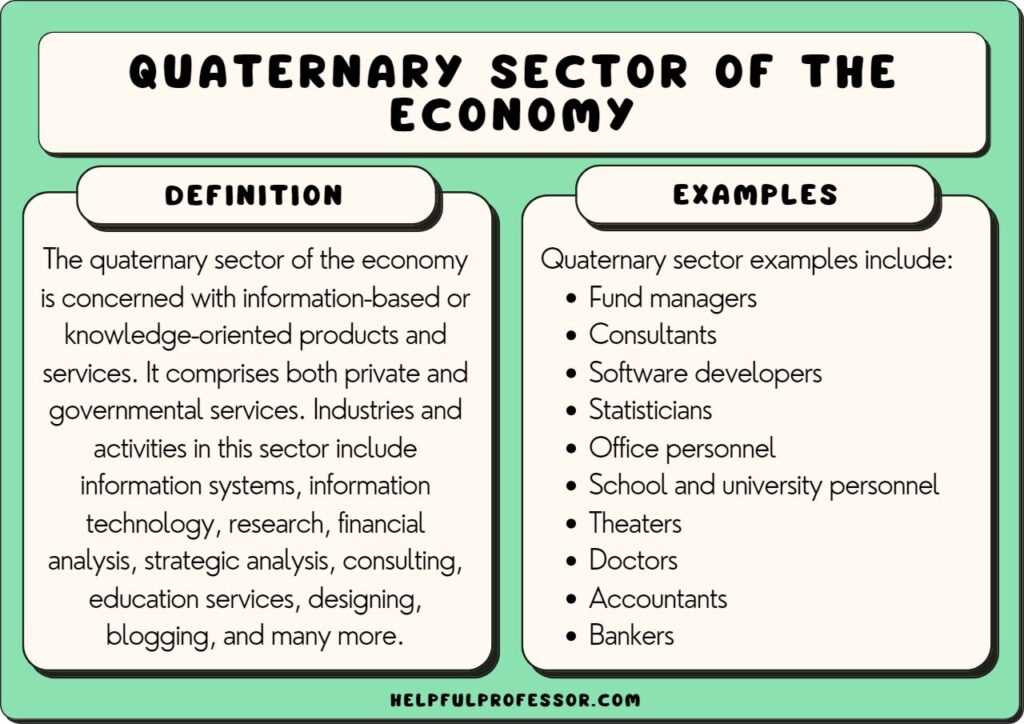What Is an Economic Sector and How Do the 4 Main Types Work?
An economic sector refers to a specific segment of the economy that shares similar characteristics and functions. The economy is typically divided into four main sectors: the primary sector, the secondary sector, the tertiary sector, and the quaternary sector. Each sector plays a crucial role in the overall functioning of the economy.
Primary Sector: Extracting and Harvesting Natural Resources
The primary sector is involved in the extraction and harvesting of natural resources from the environment. This sector includes activities such as agriculture, fishing, mining, and forestry. These industries are responsible for obtaining raw materials that can be used in the production of goods and services.
Agriculture involves the cultivation of crops and the rearing of animals for food production. Fishing involves the catching of fish and other aquatic organisms for consumption or commercial purposes. Mining involves the extraction of minerals, metals, and other valuable resources from the earth. Forestry involves the management and harvesting of forests for timber and other forest products.
Secondary Sector: Manufacturing and Construction

The secondary sector is involved in the processing and manufacturing of raw materials obtained from the primary sector. This sector includes industries such as manufacturing, construction, and utilities. The secondary sector adds value to the raw materials by transforming them into finished products that can be sold in the market.
Manufacturing involves the production of goods using various machines, tools, and labor. This sector includes industries such as automobile manufacturing, electronics manufacturing, textile manufacturing, and food processing. Construction involves the building of infrastructure, such as houses, buildings, roads, and bridges. Utilities involve the provision of essential services such as electricity, gas, and water supply.
Tertiary Sector: Providing Services

The tertiary sector is involved in providing services to individuals and businesses. This sector includes industries such as retail, hospitality, finance, healthcare, education, and transportation. The tertiary sector plays a crucial role in meeting the needs and demands of consumers and businesses.
Retail involves the sale of goods to consumers through various channels, such as stores, online platforms, and direct selling. Hospitality involves providing accommodation, food, and entertainment services to travelers and tourists. Finance involves the management of money, investments, and financial transactions. Healthcare involves the provision of medical services and healthcare facilities. Education involves the imparting of knowledge and skills through schools, colleges, and universities. Transportation involves the movement of goods and people from one place to another.
Quaternary Sector: Knowledge-based Activities
The quaternary sector is involved in knowledge-based activities that focus on research, development, and information processing. This sector includes industries such as information technology, research and development, consulting, and media. The quaternary sector plays a crucial role in driving innovation, technological advancements, and the dissemination of information.
Information technology involves the development, management, and use of computer systems, software, and networks. Research and development involve scientific and technological research to create new products and improve existing ones. Consulting involves providing expert advice and guidance to businesses and individuals. Media involves the production and distribution of information, entertainment, and news through various mediums such as television, radio, and the internet.
Primary Sector: Extracting and Harvesting Natural Resources
The primary sector is one of the four main economic sectors and is responsible for extracting and harvesting natural resources. This sector plays a crucial role in the economy as it provides the raw materials needed for various industries and sectors to function.
What is the Primary Sector?

The primary sector is often considered the foundation of the economy because it provides the necessary raw materials for the secondary and tertiary sectors. Without the primary sector, the production of goods and services in other sectors would not be possible.
Importance of the Primary Sector
The primary sector plays a vital role in the economy for several reasons:
1. Raw Material Production: The primary sector is responsible for the production of raw materials, such as minerals, metals, agricultural products, and energy resources. These raw materials are used as inputs in the manufacturing and construction industries.
2. Employment: The primary sector is a significant source of employment, especially in rural areas. It provides jobs for farmers, miners, fishermen, foresters, and other workers involved in the extraction and harvesting of natural resources.
3. Export Revenue: Many countries rely on the primary sector to generate export revenue. Natural resources, such as oil, gas, minerals, and agricultural products, are often exported to other countries, contributing to the country’s economic growth and development.
4. Economic Stability: The primary sector provides a stable foundation for the economy. It ensures a consistent supply of raw materials, which is crucial for the functioning of other sectors. A strong primary sector can contribute to economic stability and reduce dependence on imports.
Challenges and Sustainability

While the primary sector is essential for economic development, it also faces challenges and sustainability issues. Some of the challenges include environmental degradation, depletion of natural resources, and the need for sustainable practices.
Efforts are being made to promote sustainable practices in the primary sector, such as responsible mining, sustainable agriculture, and forest management. These practices aim to minimize the negative impact on the environment and ensure the long-term availability of natural resources.
Secondary Sector: Manufacturing and Construction
The secondary sector is one of the four main types of economic sectors, which focuses on the manufacturing and construction industries. This sector plays a crucial role in transforming raw materials into finished products and providing infrastructure for various economic activities.
Manufacturing Industry
The manufacturing industry is a vital component of the secondary sector. It involves the production of goods through various processes, such as assembling, processing, and fabricating raw materials. This sector encompasses a wide range of industries, including automotive, electronics, textiles, food processing, and more.
In the manufacturing industry, companies utilize machinery, tools, and labor to convert raw materials into finished products. This process often involves multiple stages, such as design, production planning, sourcing raw materials, manufacturing, quality control, and distribution.
The manufacturing sector contributes significantly to the economy by creating employment opportunities, generating revenue, and driving innovation. It plays a crucial role in global trade, as manufactured goods are exported and imported worldwide.
Construction Industry
The construction industry is another important component of the secondary sector. It involves the creation, modification, and maintenance of physical structures, such as buildings, bridges, roads, and infrastructure. This sector encompasses various activities, including residential, commercial, and industrial construction.
The construction industry involves multiple stakeholders, including architects, engineers, contractors, and laborers. It requires careful planning, design, and execution to ensure the successful completion of projects. Construction projects often involve activities such as site preparation, foundation laying, structural work, electrical and plumbing installations, and finishing touches.
The construction sector contributes to economic growth by creating jobs, stimulating demand for materials and equipment, and improving infrastructure. It plays a vital role in urban development, as it provides housing, commercial spaces, and essential facilities for communities.
Conclusion
The secondary sector, comprising the manufacturing and construction industries, plays a crucial role in the economy. It transforms raw materials into finished products, creates employment opportunities, and provides infrastructure for various economic activities. The manufacturing industry produces goods through various processes, while the construction industry focuses on creating and maintaining physical structures. Together, these sectors contribute to economic growth and development.
Tertiary Sector: Providing Services
Overview
The tertiary sector includes a diverse range of service industries such as healthcare, education, finance, transportation, hospitality, retail, and telecommunications. These industries are primarily focused on meeting the needs and demands of consumers and businesses.
Service-based businesses are often characterized by intangible outputs, meaning that the services they provide cannot be physically touched or stored. Instead, they are experienced or consumed at the time of production. For example, when you visit a restaurant, you are consuming the service of food preparation and dining experience.
Importance
Service industries also play a crucial role in supporting other sectors of the economy. For example, transportation services enable the movement of goods and people, facilitating trade and economic activity. Financial services help businesses and individuals manage their money and invest in productive activities.
Trends and Challenges
The tertiary sector has experienced significant growth in recent decades, driven by factors such as technological advancements, globalization, and changing consumer preferences. The rise of digital technologies has enabled the expansion of online services, transforming industries such as retail, entertainment, and communication.
However, the service sector also faces challenges. One of the main challenges is the increasing automation and digitalization of services, which can lead to job displacement and require workers to acquire new skills. Additionally, the sector is vulnerable to economic downturns, as consumers may reduce their spending on non-essential services during times of financial uncertainty.
Conclusion
The tertiary sector plays a vital role in the economy by providing a wide range of services to individuals and businesses. It creates employment opportunities, drives economic growth, and supports other sectors of the economy. As technology continues to advance, the service sector will need to adapt and innovate to meet changing consumer demands and overcome challenges.
Quaternary Sector: Knowledge-based Activities
The quaternary sector is a crucial part of the modern economy, focusing on knowledge-based activities that involve the creation, manipulation, and dissemination of information. This sector plays a vital role in driving innovation, technological advancements, and economic growth.
Definition and Examples
The quaternary sector encompasses activities that involve research and development, information technology, education, consulting, and other knowledge-based services. It includes industries such as software development, telecommunications, financial services, scientific research, and higher education.
One of the key characteristics of the quaternary sector is its reliance on highly skilled professionals who possess specialized knowledge and expertise. These professionals are often involved in creating new technologies, conducting research, analyzing data, and providing strategic advice to businesses and organizations.
For example, in the software development industry, professionals with expertise in programming and coding create new software applications and systems that drive innovation in various sectors. In the financial services industry, analysts and consultants use their knowledge to provide investment advice and develop financial strategies for clients.
Importance and Impact
The quaternary sector plays a crucial role in driving economic growth and competitiveness. It fosters innovation by developing new technologies, products, and services that enhance productivity and efficiency in other sectors. The advancements in information technology, for instance, have revolutionized various industries and transformed the way businesses operate.
Furthermore, the quaternary sector contributes to job creation and higher wages. The demand for highly skilled professionals in knowledge-based activities has been increasing, leading to the creation of new job opportunities. These jobs often require specialized skills and knowledge, resulting in higher wages compared to other sectors.
Moreover, the quaternary sector also plays a significant role in the development of human capital. It provides educational and research opportunities that contribute to the overall knowledge and skill level of the workforce. This, in turn, enhances the competitiveness of a country or region in the global economy.
Challenges and Future Trends
Another challenge is the increasing competition in the global market. As more countries invest in knowledge-based activities, the competition for talent and resources intensifies. This requires countries and organizations to develop strategies to attract and retain highly skilled professionals.
Furthermore, the quaternary sector is also experiencing a shift towards remote work and digital platforms. The COVID-19 pandemic has accelerated this trend, with many knowledge-based activities being conducted remotely. This shift presents both opportunities and challenges in terms of collaboration, communication, and cybersecurity.

Emily Bibb simplifies finance through bestselling books and articles, bridging complex concepts for everyday understanding. Engaging audiences via social media, she shares insights for financial success. Active in seminars and philanthropy, Bibb aims to create a more financially informed society, driven by her passion for empowering others.
